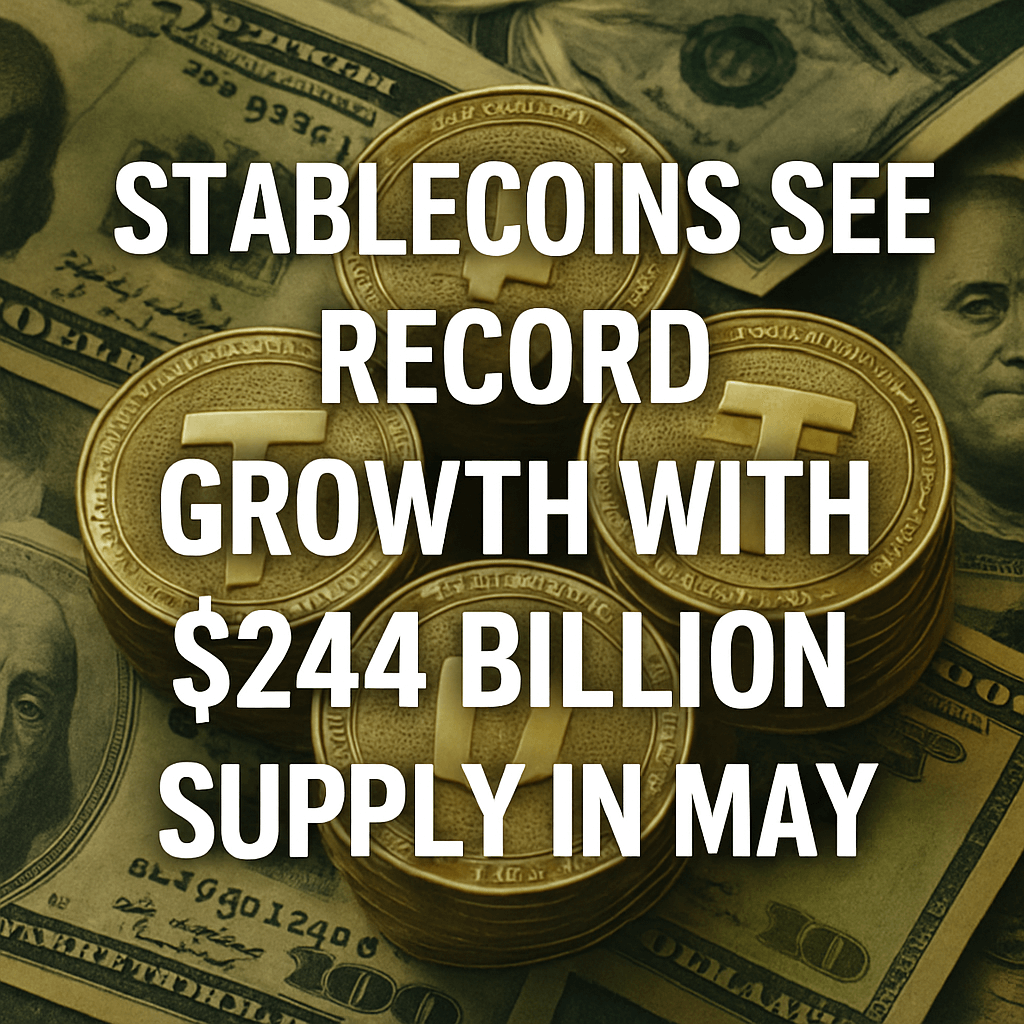Stablecoins See Record Growth with $244 Billion Supply in May

A remarkable surge in stablecoin transactions marked May 2023 as a standout month for the cryptocurrency sector. The activity transcended mere token swaps, illustrating a significant shift in the use of dollar-pegged coins for various financial transactions. This surge hints that stablecoins are rapidly becoming the primary channel for on-chain payments.
Rise in Wallet Activity
According to data from Artemis, over 33 million wallets engaged in sending or receiving stablecoins during the month of May, indicating a significant uptick compared to previous months. This trend demonstrates a growing reliance on these digital dollars among traders, decentralized finance (DeFi) users, and everyday consumers, who opted for stablecoins to maintain their funds’ stability tied to the US dollar. This wave of activity coincided with a broader recovery in the cryptocurrency market, as prices began to see a slow but optimistic ascent, reflected in rising investor confidence.
Shift to Faster Networks
Notably, the BNB Smart Chain and TRON networks emerged as frontrunners during this period. BNB Smart Chain reported over 10 million active wallets conducting stablecoin transactions in early May, while TRON closely followed with over 9 million wallets. These networks offer the advantages of lower fees and faster transaction speeds, effectively attracting users looking to avoid the higher costs associated with more established chains such as Ethereum.
- BNB Smart Chain: 10 million active stablecoin wallets
- TRON: 9 million active stablecoin wallets
Analysts project that both BNB Smart Chain and TRON potential surpass these figures again as user adoption of these economical alternatives continues to grow, emphasizing an increasing demand for swift and affordable payment solutions within the crypto ecosystem.
Stablecoin Supply Growth
As the user base expanded, the supply of stablecoins also experienced notable growth. By the end of May, the total supply reached a staggering $244 billion, marking an increase of nearly 3% within just one month. However, the distribution of new tokens varies significantly among different stablecoin offerings.
Tether’s USDT continues to dominate the market as the leading stablecoin, adding nearly $4 billion to its total supply during May alone. A majority of this influx found its way onto the TRON network, which now holds approximately $78 billion in USDT, surpassing Ethereum’s $73 billion. Currently, USDT’s total supply stands at over $153 billion, with new tokens continuously minted almost every day.
Conversely, USD Coin (USDC) experienced a slight downturn in supply, primarily due to outflows on the Solana network. Nevertheless, USDC maintains a robust presence, with approximately $60 billion circulating across its various blockchain deployments.
New Payment Paradigms: Stablecoins vs. Traditional Financial Systems
In the last 30 days, stablecoins not only grew in supply but also facilitated a staggering volume of transactions, with over $2 trillion worth of value moved. This remarkable volume surpasses the transaction figures of many traditional debit and credit cards. For instance, Visa’s transaction volumes were eclipsed by stablecoin activity during the same period—demonstrating the disruptive potential of these digital assets.
Additionally, USDC’s cross-chain movement experienced a significant spike, especially through the Cross-Chain Transfer Protocol (CCTP), which reported a volume of $7.7 billion—an increase of 83% compared to the previous month. This surge in bridging activity underscores that a growing number of users are utilizing stablecoins to transfer value across different networks, facilitating trades, lending, and simple transfers more efficiently.
Future Outlook for Stablecoins
Industry experts view the sustained growth of stablecoins as a critical development in the cryptocurrency landscape. This uptick signals a potential long-term shift in how individuals engage with digital currencies, emphasizing stability and low-cost transactions. As adoption continues, regulatory frameworks will likely evolve, further shaping the future of stablecoin use in everyday financial activities.
Expert Opinion: “Stablecoins are positioned to fill gaps in the financial ecosystem, providing a conduit for seamless transactions that traditional finance struggles to match,” commented Dr. Miriam Lewis, crypto economist.
Conclusion
The substantial growth in both the user base and supply of stablecoins during May illustrates their increasingly vital role within the broader cryptocurrency market. As user preference shifts towards low-cost, fast transaction methods, stablecoins like USDT and USDC are poised to continue their upward trajectory, transforming how value is exchanged and perceived in the digital finance space.